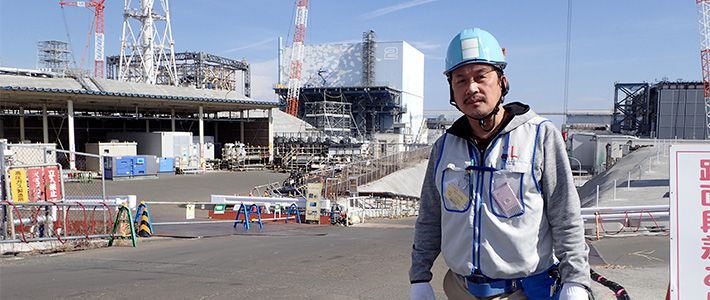
Fukushima Daiichi Today: Successes and Setbacks
Society- English
- 日本語
- 简体字
- 繁體字
- Français
- Español
- العربية
- Русский
I began reporting on the situation at the Fukushima Daiichi Nuclear Power Station in the immediate aftermath of the March 2011 meltdown six years ago. I saw the reactor buildings wrecked by multiple hydrogen explosions and the crew members covered in white full-body radiation suits, continually alerted to danger by alarms from their radiation monitors. I witnessed their desperate years-long battle to contain and decontaminate radioactive water and halt its accumulation.
The scene that greeted me this time around was quite different. As part of a multi-pronged effort to curb groundwater contamination, they have paved over a large percentage of the site to prevent rainwater from seeping underground and into leaky reactor buildings. To be sure, rows of huge cylindrical tanks—more than 900 at last count—still stand as a reminder of the magnitude of the water-contamination problem at the plant. But the highly radioactive water originally stored in those containers has undergone repeated filtration and processing, so that today they emit only low levels of radiation. Most of the site is now safe to tour without special radiation protection gear. The general ambience is much like that of a typical construction site, with crew members chatting and joking as they stroll across the grounds.
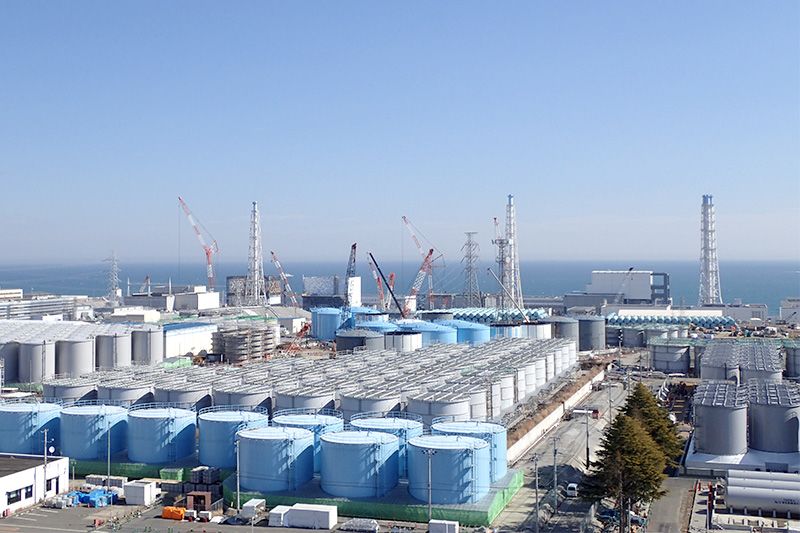 TEPCO’s Fukushima Daiichi Nuclear Power Station as viewed from the west. Beyond the rows of tanks built to store contaminated water stand the reactor buildings where multiple meltdowns occurred. (Photographed by the author on February 17, 2017.)
TEPCO’s Fukushima Daiichi Nuclear Power Station as viewed from the west. Beyond the rows of tanks built to store contaminated water stand the reactor buildings where multiple meltdowns occurred. (Photographed by the author on February 17, 2017.)
Needless to say, this atmosphere of normalcy and easy access does not apply to the stricken reactor buildings, where experts are struggling to gather the information they need to begin removing molten fuel and other radioactive debris. The current focus of this effort is the plant’s Unit 2 reactor, which has drawn intense and often misleading media coverage in recent weeks.
Alarmist Media Reports
In early February this year, numerous foreign media outlets carried erroneous reports of spiking radiation levels at Fukushima Daiichi Power Station. The impetus for the rumors appears to have been a statement from Tokyo Electric Power Company on the findings of an investigation to assess the situation inside the Unit 2 reactor’s primary containment vessel. Penetrating deep into the PCV for the first time, a camera probe detected extremely high radiation levels, estimated in excess of 500 sieverts per hour.
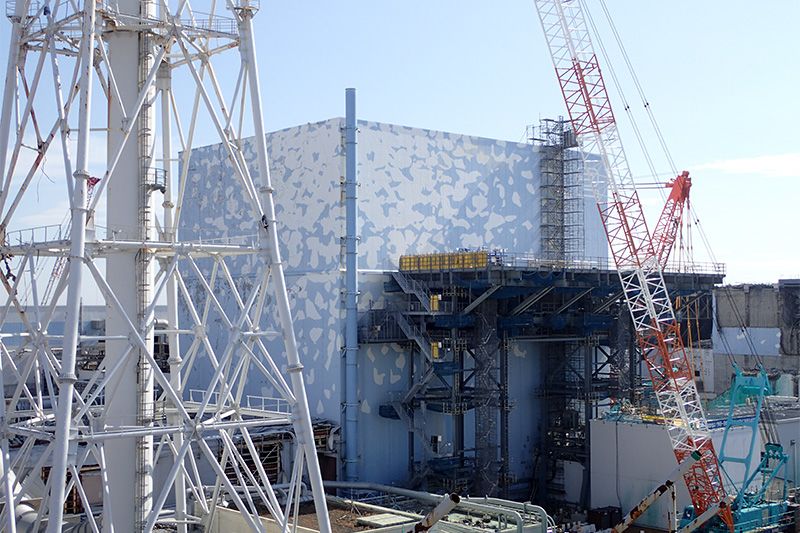 Unit 2 reactor building at Fukushima Daiichi. (Photographed by the author on February 17, 2017.)
Unit 2 reactor building at Fukushima Daiichi. (Photographed by the author on February 17, 2017.)
This is unquestionably a lethal dose, much higher than levels previously recorded at the Fukushima Daiichi site in the wake of the 2011 accident. But that is to be expected, since it represents the first measurement taken inside the primary containment vessel. It was already known that molten fuel from the reactor core had dropped down into the PCV during the accident, and the investigating team fully expected to find intense levels of radiation inside the containment vessel once it was able to take measurements. But the PCV is tightly sealed, and there has been no change in the radiation levels outside the vessel. The grounds in the vicinity of the building are safe, as I myself can attest. There is no danger of further contamination of the external environment, much less leakage of lethal doses of radiation. The overseas media seized on the radioactivity inside the PCV without mentioning that it is contained and poses no threat to the surrounding area.
Six years after the nuclear accident, Fukushima Prefecture is still struggling to recover from the economic impact of malicious rumors and exaggerated reports of radioactive contamination. Misinformation of this sort could deal a devastating setback to those efforts. We can only do our best to combat such irresponsible reporting by working ever more zealously to disseminate accurate information.
Successful Camera Probe
Let us now return to the recent investigation of Unit 2 and assess its true significance.
Unit 2 was among the three reactors that were operating on March 11, 2011, when a massive tsunami triggered by the Great East Japan Earthquake hit the Fukushima Daiichi Nuclear Power Station. Although the reactors automatically shut down in response to the quake, the tsunami knocked out the plant’s power sources, disabling the cooling systems and causing the fuel in all three reactors to melt. The molten fuel dropped out of the reactor cores and melted structural components of the reactors. This fuel debris, as it is known, fell down into the lower sections of the primary containment vessels in which the reactors are sealed.
As one key step in the long process of dismantling and decontaminating the facilities, TEPCO has joined with Toshiba and the International Research Institute for Nuclear Decommissioning (IRID) in an effort to investigate the location and state of the fuel debris inside Unit 2’s PCV using remote-controlled equipment. In late January, the team launched the first phase of this effort.
The PCV is a massive metal and concrete structure shaped like a flask with a spherical bottom. In the core of the vessel is a cylindrical concrete enclosure known as the pedestal, which houses the reactor pressure vessel. To penetrate the thick walls of the PCV, the team made use of an existing conduit known as X-6, a pipe about 60 centimeters in diameter through the wall of the vessel’s lower, spherical portion. Inside the PCV, the pipe connects with a maintenance rail (sometimes referred to as the CRD rail), a bridge 60 cm wide and 7.2 meters long used in the replacement of reactor components. The maintenance rail leads to a round platform made of metal grating right beneath the pressure vessel.
Since X-6 is normally sealed with a thick steel plug, a hole had to be drilled to provide access. After lead shielding was installed to allow workers to approach safely, a hole 11.6 cm in diameter was drilled through the plug. On January 26, a camera was inserted through the hole and into the PCV on a telescoping pole, then guided part of the way along the maintenance rail. Visual images recorded by the camera ascertained that there were no large obstacles blocking this access route.
On January 30, another camera probe was launched along the same route, and this one penetrated far enough to film a portion of the platform underneath the pressure vessel. This was the first time since the 2011 accident that a camera had gained access to the space beneath one of the disabled reactors. The images it transmitted are a vivid testimony to the impact of the meltdown. In the photographs, the platform’s steel grating, heavily encrusted with brownish-black deposits, sags in the middle like pulled taffy.
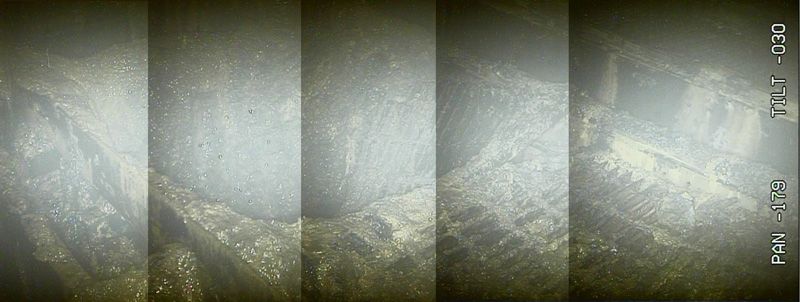 The deformed steel grating under the Unit 2 reactor as filmed on January 30, 2017. Some sections of the platform were determined to have melted away. (Courtesy of IRID)
The deformed steel grating under the Unit 2 reactor as filmed on January 30, 2017. Some sections of the platform were determined to have melted away. (Courtesy of IRID)
In addition to the deformation, assumed to be caused by intense heat, the probe detected several sections of the platform that had melted away entirely, including a large hole about one meter square. While the probe was not equipped to directly measure the ambient temperature or radioactivity (and therefore could not positively identify the deposits as fuel debris), it was possible to estimate radiation levels along the maintenance rail from the amount of optical “noise” picked up by the camera. This analysis yielded a maximum level of 530 Sv/hr. (This was the figure that overseas media outlets seized on, conveying the impression that radiation levels had spiked at Fukushima Daiichi.)
The next probe was carried out on February 9. During this phase of the investigation, a self-propelled robot followed the same route. This remote-controlled device used high-pressure water jets to remove some of the deposits previously detected on the maintenance rail in order to clear a path for a full-scale inspection by the self-propelled Sasori (scorpion) robot. The deposits, thought to consist of melted paint and cable insulation from inside the PCV, were up to 2 cm thick and covered a segment of the rail about 5 meters long. Although the robot managed to clean away about two meters of that, the work had to be cut short when high radiation began causing the camera to malfunction. This outcome was to have a decisive impact on the subsequent Sasori probe.
From photos taken by the cleaning robot, the team estimated radiation levels as high as 650 Sv/hr along the maintenance rail. Curiously, however, photos from the area directly underneath the reactor have yielded estimates of only 20 Sv/hr. If these estimates are valid, then radiation levels are 20 to 30 times higher outside the concrete pedestal than right beneath the reactor, where the fuel debris is assumed to have fallen. What could be the source of such intense radiation outside the pedestal?
The question has stumped the cleanup team, including Masuda Naohiro, president and chief decommissioning officer of Fukushima Daiichi D&D Engineering Company. “To be honest, we’re like, ‘What?’ One could understand if it were the other way around, but if radiation levels are higher outside [the pedestal], there must be something [highly radioactive] out there. But no one can imagine what that would be. On the other hand, 20 sieverts seems too low for the area directly under the reactor. We’re going to need actual dosimeter and thermometer readings to determine whether or not the deposits on the platform underneath the reactor are from melted fuel debris or something else.”
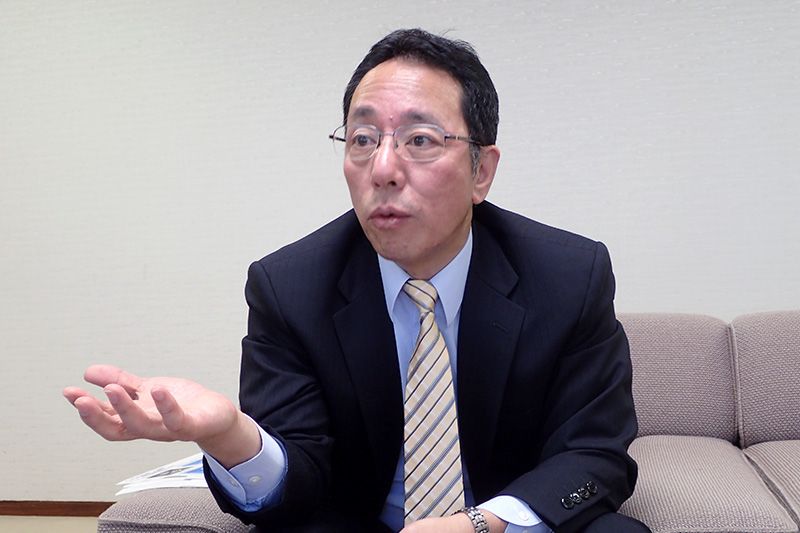 Masuda Naohiro, president of the company set up to supervise the decommissioning effort.
Masuda Naohiro, president of the company set up to supervise the decommissioning effort.
Limits of the Scorpion Robot
At the time, the best hope to shed light on this and other important questions was the Sasori robot, jointly developed by IRID and Toshiba. The Sasori is a self-propelled remote-controlled robot mounted with front and rear cameras as well as a dosimeter, a thermometer, and other measurement equipment. The Sasori was designed to fold into a compact bar shape just 9 centimeters tall and 60 centimeters long in order to crawl through narrow spaces. Once it enters open space, it can raise its “tail” to various angles to survey and photograph the area, while measuring temperature and radiation.
On February 16, following the preparatory probes described above, the team sent its Sasori robot into the containment vessel. Unfortunately, this phase of the investigation was not a resounding success. Before the robot could reach the pedestal and inspect the fuel debris inside, it ran aground on the deposits that the previous probe had failed to remove. Moreover, the robot’s crawler belt broke down, forcing the team to cut the robot’s cable and abandon the device on the maintenance rail.
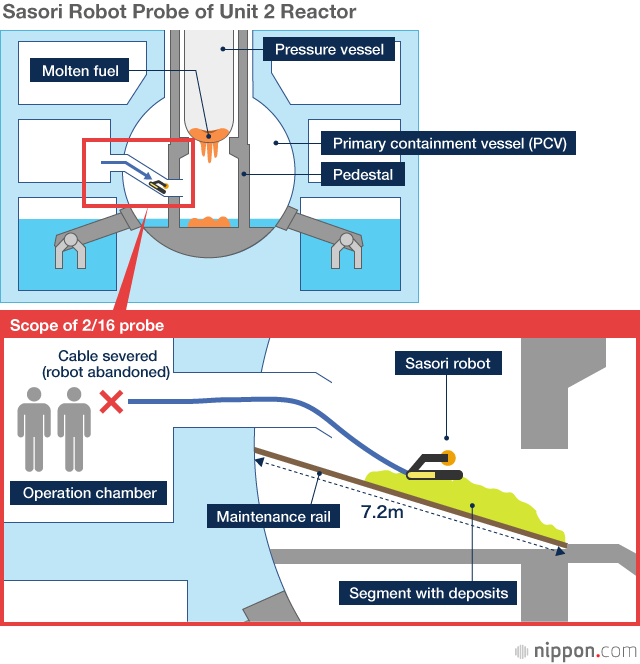
The Sasori probe was the centerpiece of a project that has cost over a billion yen, and as such its failure is unfortunate. But that does not negate the progress the investigation as a whole has made. The visual data obtained from the earlier camera probe was a breakthrough and a key step in the development of a plan for removing fuel debris from the bottom of the containment vessel.
Removing this fuel debris constitutes the biggest obstacle to final dismantling of the plant’s reactors. It is also the first such effort in human history. One can scarcely expect each phase of such an unprecedented endeavor to proceed according to plan. Kuwabara Hirohisa, general manager of IRID’s R&D Strategy Planning Department, put it succinctly: “If we stumble, we just have to pick ourselves up and keep moving forward.”
Under the current decommissioning “roadmap,” fuel debris removal is supposed to begin by 2021, but whether the team can meet that target is open to question, especially given the recent setback.
“Fuel removal will have to be carried out entirely by remote-controlled equipment in an extremely radioactive environment,” says Kuwabara. “Unless we proceed very deliberately with the development of that equipment, we run the risk that it will break down in the middle of the process, and we’ll have to suspend work. At the same time, we have to figure such risks into our planning, so that we’ll have a fallback plan in the event that things go wrong.”
In short, fuel debris removal will require the development of sophisticated new methods, and the specific methods adopted will depend on the location and state of the debris. Even in Unit 2, where inspection of the PCV has made the most progress, vital information is still lacking.
At this point, the team has no choice but to accept the results of the latest investigation in all humility, even if it means a wholesale shift in strategy. Haste or impatience might lead to missteps that could exacerbate the situation and set the decommissioning effort back by many years. Such a reversal must be avoided at all costs.
Open-Door Policy
Near the beginning of this article, I stated that radiation levels on the grounds of Fukushima Daiichi had fallen to the point where the ambience was similar to that of a typical construction site. Anyone who has not visited the plant may find that hard to believe, but it is true. I walked around the site with a radiation monitor for about three hours, and the total dose registered was 0.03 millisieverts—roughly the same as that from a single chest X-ray.
Such is the safety of the Fukushima Daiichi site that the number of visitors has risen to about 8,000 annually. As of the end of December 2016, close to 30,000 observers had visited the plant site since the accident. Initially, the overwhelming majority of observers were scientists, engineers, and government officials. But nowadays it is not unusual to see groups of university or high school students standing atop a hill with a view of the reactor buildings, wearing helmets and surgical masks provided by TEPCO.
Number of Visitors to Fukushima Daiichi Site
| Fiscal Year | Number of Visitors (Non-Japanese) |
|---|---|
| 2011 | 913 |
| 2012 | 2,753 |
| 2013 | 3,798 |
| 2104 | 5,409(694) |
| 2015 | 8,000(870) |
| 2016 | 7,945(558) |
| Total | 28,818 |
Source: Tokyo Electric Power Company. Figures for 2016 are to the end of December
These tours reflect the open-door policy of chief decommissioning officer Masuda, who has committed himself to transparency and public outreach. “I want our young people, the leaders of tomorrow, to understand the situation at Fukushima Daiichi now and what we’re trying to achieve in the future,” he says. “I’m sure a lot of people harbor suspicions that something dangerous is going on here, and that TEPCO is trying to cover it up. That’s why I feel it’s important for people to come and see for themselves.”
Not everyone will come away from Fukushima Daiichi Nuclear Power Station with the same impressions, but in my view there is profound significance to having those who will inherit the legacy of Fukushima set foot on the scene of the worst nuclear accident in history. I pray that as many young people as possible will take advantage of this opportunity to visit the site and reflect somberly on the issues posed by nuclear power.
(Originally published in Japanese on March 6, 2017.Banner photo: The author on the grounds of Fukushima Daiichi Nuclear Power Station, February 17, 2017. In the background, about 150 meters to the east, stands the Unit 2 reactor building, where probes recently penetrated the primary containment vessel in order to locate fuel debris from the meltdown.)Great East Japan Earthquake Fukushima Daiichi Nuclear Power Station TEPCO